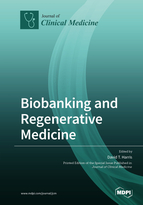Biobanking and Regenerative Medicine
A special issue of Journal of Clinical Medicine (ISSN 2077-0383). This special issue belongs to the section "Immunology".
Deadline for manuscript submissions: closed (5 January 2019) | Viewed by 34029
Special Issue Editor
Interests: stem cells; regenerative medicine; tissue engineering; cancer; umbilical cord blood and tissue; adipose-derived stem cells; aging
Special Issues, Collections and Topics in MDPI journals
Special Issue Information
Dear Colleagues,
Regenerative medicine and tissue engineering play significant roles in the treatment of currently intractable conditions, such as chronic heart failure, stroke, chronic osteoarthritis, and other maladies. Regenerative medicine and tissue engineering generally depend on the utilization of stem cells to treat patients but may also utilize mature cells that would not normally be considered as stem cells (e.g., skin). Stem cells (like mature cells) may be obtained from many sources in the body including bone marrow, cord blood, cord tissue, adipose tissue, etc. Although stem cells are often used in therapy immediately upon isolation, in many circumstances the stem and progenitor cells will be harvested, processed and banked frozen until a later time. Biobanking is a convenient alternative to same-day therapeutic use, in that it allows for patient recovery (e.g., from liposuction), provides time to identify the best treatment options, and may allow for multiple interventions with additional patient inconvenience or risk.
This Special Issue will be addressed to the topic of “Biobanking and Regenerative Medicine”. Papers are welcomed on topics such as stem cell banking (e.g., cord blood, cord tissue, bone marrow, adipose tissue methodology), utilization of biobanked stem cells in pre-clinical and clinical trials, and mature cell biobanking and utilization in animal models and clinical trials (e.g., cardiomyocytes and blood vessels). Special emphasis should be put upon the role that biobanking plays in clinical therapy, precision medicine, and “big data”.
Prof. Dr. David T. Harris
Guest Editor
Manuscript Submission Information
Manuscripts should be submitted online at www.mdpi.com by registering and logging in to this website. Once you are registered, click here to go to the submission form. Manuscripts can be submitted until the deadline. All submissions that pass pre-check are peer-reviewed. Accepted papers will be published continuously in the journal (as soon as accepted) and will be listed together on the special issue website. Research articles, review articles as well as short communications are invited. For planned papers, a title and short abstract (about 100 words) can be sent to the Editorial Office for announcement on this website.
Submitted manuscripts should not have been published previously, nor be under consideration for publication elsewhere (except conference proceedings papers). All manuscripts are thoroughly refereed through a single-blind peer-review process. A guide for authors and other relevant information for submission of manuscripts is available on the Instructions for Authors page. Journal of Clinical Medicine is an international peer-reviewed open access semimonthly journal published by MDPI.
Please visit the Instructions for Authors page before submitting a manuscript. The Article Processing Charge (APC) for publication in this open access journal is 2600 CHF (Swiss Francs). Submitted papers should be well formatted and use good English. Authors may use MDPI's English editing service prior to publication or during author revisions.
Keywords
- Biobanking
- Regenerative medicine
- Adipose stem cells
- Hematopoietic stem cells
- Mesenchymal stem cells
- Cord blood
- Tissue engineering







